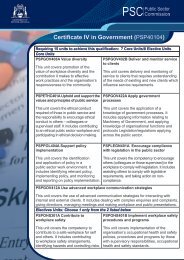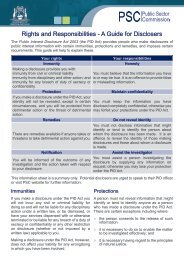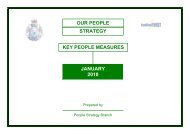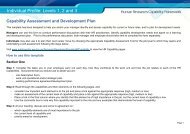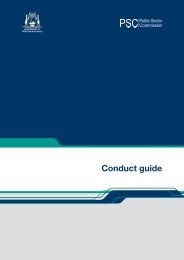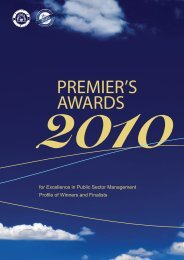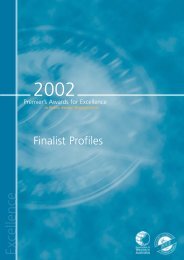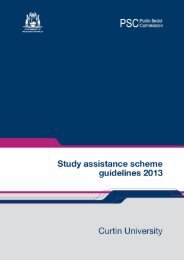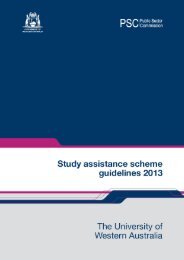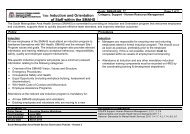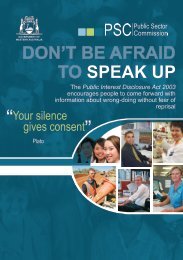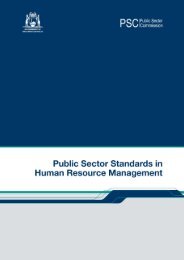A Guide to Managing an Ageing Workforce - Public Sector ...
A Guide to Managing an Ageing Workforce - Public Sector ...
A Guide to Managing an Ageing Workforce - Public Sector ...
Create successful ePaper yourself
Turn your PDF publications into a flip-book with our unique Google optimized e-Paper software.
2. Meeting the Challenge<br />
The challenge is <strong>to</strong> create a work environment that will attract <strong>an</strong>d retain mature employees <strong>to</strong> work beyond<br />
retirement age. It is crucial <strong>to</strong> build awareness of the impacts of ch<strong>an</strong>ging workforce demographics <strong>an</strong>d <strong>to</strong><br />
equip leaders across the sec<strong>to</strong>r with the skills <strong>to</strong> m<strong>an</strong>age <strong>an</strong> ageing workforce.<br />
This guide provides practical advice <strong>an</strong>d techniques for agencies <strong>to</strong>:<br />
• attract mature employees<br />
• retain current mature employees in the sec<strong>to</strong>r for longer<br />
• retain <strong>an</strong>d improve the use of mature employees’ knowledge <strong>an</strong>d skills<br />
• tr<strong>an</strong>sfer knowledge <strong>an</strong>d skills from mature <strong>to</strong> newer employees<br />
• build a diverse <strong>an</strong>d inclusive workforce<br />
Retirement fac<strong>to</strong>rs<br />
The <strong>to</strong>p fac<strong>to</strong>rs rated by WA public sec<strong>to</strong>r employees as being the most influential in their decision <strong>to</strong> retire x are:<br />
• Opportunities exist <strong>to</strong> develop<br />
best practice models <strong>to</strong> support<br />
a longer work life, phased<br />
retirement <strong>an</strong>d knowledge<br />
m<strong>an</strong>agement<br />
• The public sec<strong>to</strong>r with its ageing<br />
workforce profile <strong>an</strong>d employment<br />
size has a unique leadership role<br />
<strong>to</strong> play in response <strong>to</strong> ch<strong>an</strong>ges in<br />
the labour market environment<br />
• fin<strong>an</strong>cial security (97%)<br />
• job satisfaction (93%)<br />
• work/life bal<strong>an</strong>ce (91%)<br />
• more time <strong>to</strong> pursue leisure activities (84%)<br />
• job stress/pressure (84%)<br />
Although mature employees may remain in, or return <strong>to</strong> work for economic reasons, m<strong>an</strong>y do so because<br />
they w<strong>an</strong>t <strong>to</strong> be active xi . M<strong>an</strong>y mature employees w<strong>an</strong>t <strong>to</strong> continue <strong>to</strong> work - the key is <strong>to</strong> make work practices<br />
more attractive <strong>to</strong> them by addressing the fac<strong>to</strong>rs above.<br />
To retain mature employees for longer, it is critical <strong>to</strong> underst<strong>an</strong>d why they leave. Information on how <strong>to</strong><br />
design, implement <strong>an</strong>d evaluate exit surveys c<strong>an</strong> be found in the <strong>Public</strong> Sec<strong>to</strong>r Commission publication,<br />
Learning from Leaving<br />
www.publicsec<strong>to</strong>r.wa.gov.au A <strong>Guide</strong> <strong>to</strong> <strong>M<strong>an</strong>aging</strong> <strong>an</strong> <strong>Ageing</strong> <strong>Workforce</strong> 7




